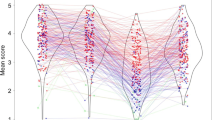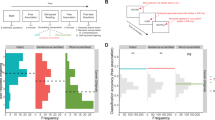Abstract
Studies of verbal reports have always assumed that thoughts verbalized on a given occasion are not the only ones that could have been expressed. This poses a potential problem for a recently developed thinkaloud procedure called Articulated Thoughts in Simulated Situations (ATSS). To address this issue, comparisons were made between the articulated thoughts of subjects over two presentations of a simulated stressful event in the ATSS procedure. Articulated thoughts were analyzed for similarity across presentations both topographically for surface content and inferentially for the amount of irrationality. While the topographic analysis generally suggested a lack of stability across presentations, the inferential analysis revealed little change. The suggestion is made that incomplete verbal protocols are not problematic for ATSS if the coding strategy taps into the underlying structure presupposed by one's theoretical interest.
Similar content being viewed by others
References
Davison, G. C., Feldman, P. M., & Osborn, C. C. (1984). Articulated thoughts, irrational beliefs, and fear of negative evaluation.Cognitive Therapy and Research, 8, 349–362.
Davison, G. C., Robins, C., & Johnson, M. K. (1983). Articulated thoughts during simulated situations: A paradigm for studying cognition in emotion and behavior.Cognitive Therapy and Research, 7, 17–40.
Ellis, A. (1962).Reason and emotion in psychotherapy. Secaucus, NJ, Lyle Stuart.
Ericsson, K. A., & Simon, H. A. (1980). Verbal reports as data.Psychological Review, 87, 215–251.
Kendall, P. C., & Hollon, S. D. (1981). Assessing self-referent speech: Methods in the measurement of self-statements. In P. C. Kendall & S. D. Hollon (Eds.),Assessment strategies for cognitive behavioral interventions (pp. 85–118). New York, Academic Press.
Meichenbaum, D., & Cameron, R. (1981). Issues in cognitive assessment: An overview. In Merluzzi, T. V., Glass, C. R., & Genest, M. (Eds.),Cognitive Assessment (pp. 3–15). New York, Guilford Press.
Nisbett, R. E., & Wilson, T. D. (1977). Telling more than we can know: Verbal reports on mental processes.Psychological Review, 84, 231–259.
Author information
Authors and Affiliations
Additional information
Kennon Kashima, M.A., is a member of the core faculty in psychology at Goddard College. Gerald, C. Davison, Ph.D., is the Chair and Professor of Psychology, University of Southern California.
We extend thanks to Thomas Weiler for running the subjects, to Kevin Brown and Sandra Lew for doing the inferential content analysis, and to Sharon Dolezal and David Haaga for conducting the topographical content analysis.
Rights and permissions
About this article
Cite this article
Kashima, K., Davison, G.C. Functional consistency in the face of topographical change in articulated thoughts. J Rational-Emot Cognitive-Behav Ther 7, 131–139 (1989). https://doi.org/10.1007/BF01076185
Issue Date:
DOI: https://doi.org/10.1007/BF01076185




